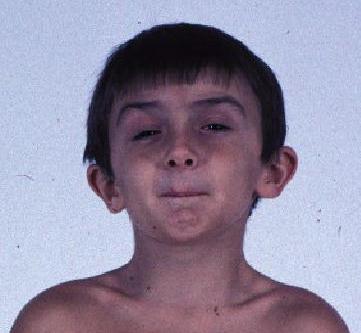Schwartz-Jampel Syndrome (SJS)
Clinical information
Schwartz-Jampel syndrome is a very rare disease that commonly involves abnormalities of skeletal muscle, bone, and cartilage. One common muscle problem is myotonia. Myotonia is a condition involving muscle spasms and muscular rigidity; myotonic muscles are slow to relax after being contracted. Myotonia can cause narrowed eye openings and pursed lips in SJS patients (see photo at right). Patients also have growth delays. Cognitive ability can be affected in SJS, but is usually not. Musculoskeletal problems in SJS can be severe. They include the following:
- Continuous spontaneous activity on an electromyogram
- Joint contractures
- Pectus carinatum (pigeon chest)
- Abnormal curvature of the vertebrae (scoliosis, kyphosis, lordosis)
- Hip dysplasia, including coxa vara and coxa valga
- Deformities of the fingers
- Clubfoot and/or flat feet
- Osteoporosis
- Both muscle hypertrophy and atrophy
- Chondrodystrophy (abnormalities of the cartilage)
Musculoskeletal problems
Pigeon chest and other deformities in SJS are secondary to myotonia and are often treated surgically. These problems are progressive, but have been slowed by the use of carbamazepine (1-3; list not exhaustive). Carbamazepine may also improve growth. The joint stiffness that occurs in SJS appears to peak in adolescence, and the disease may stabilize in adulthood.
- Small mouth
- Low-set ears
- Puckered chin
- Short neck
- High-pitched or nasal voice
- Blepharospasm (sustained, forced closing of the eyelids)
- Ptosis of the eyelid
- Extra eyelashes
- Highly arched palate
- Myopia/nearsightedness
Other manifestations
In addition, SJS patients are at increased risk for malignant hyperthermia (MH). This condition results from exposure to certain anesthetics, such as halothane or cyclopropane, or muscle relaxants such as succinylcholine. MH is a sudden rise in body temperature; without treatment, it can be life-threatening. Other signs of MH are muscle twitching and stiffness, headache, nausea/vomiting, low blood pressure, and a rapid or irregular heartbeat.
In making a diagnosis, SJS should be distinguished from Stuve-Wiedemann syndrome. Other diseases that resemble SJS include Morquio syndrome/mucopolysaccharidosis IV, Freeman-Sheldon syndrome, King syndrome, Marden-Walker syndrome, and Van Dyke-Hanson syndrome.
Clincians and others may wish to read reference 4, which is a short review on SJS.
SJS can be confirmed by testing for mutations in the gene HSPG2. Diagnosis can also be performed by a complete clinical evaluation. This evaluation would typically include a detailed patient history, and specialized tests, including electromygraphy (an EMG) to look for myotonic myopathy. This term means that complete electromyographic silence is not obtained, even if the muscle is at rest. This finding is very common in SJS patients. Other tests include muscle biopsies and examination of serum aldolase (may be elevated in SJS patients).
References
- 1. Topaloğlu H et al. (1993) Improvement of myotonia with carbamazepine in three cases with the Schwartz-Jampel syndrome. Neuropediatrics 24(4):232-234. Abstract on PubMed.
- 2. Squires LA & Prangley J (1996) Neonatal diagnosis of Schwartz-Jampel syndrome with dramatic response to carbamazepine. Pediatric Neurology 15(2): Abstract on PubMed.
- 3. Reed UC et al. (2002) Schwartz-Jampel syndrome: report of five cases. Arq. Neuro-Psiquiatr 60(3B):734-738. Full text from Scielo.
- 4. Berardinelli A et al. (1997) The Schwartz-Jampel syndrome. A minireview. Basic Appl Myol 7(6):363-367. Full text.
- 5. Kaisse AA et al. (2012) Windswept deformity in a patient with Schwartz-Jampel syndrome. Swiss Med Wkly 142:w13519. doi: 10.4414/smw.2012.13519. Full text available from publisher.
- 6. Ho NC et al. (2003) Clinico-pathogenetic findings and management of chondrodystrophic myotonia (Schwartz-Jampel syndrome): a case report. BMC Neurol 3:3. doi: 10.1186/1471-2377-3-3 Full text on PubMed.


